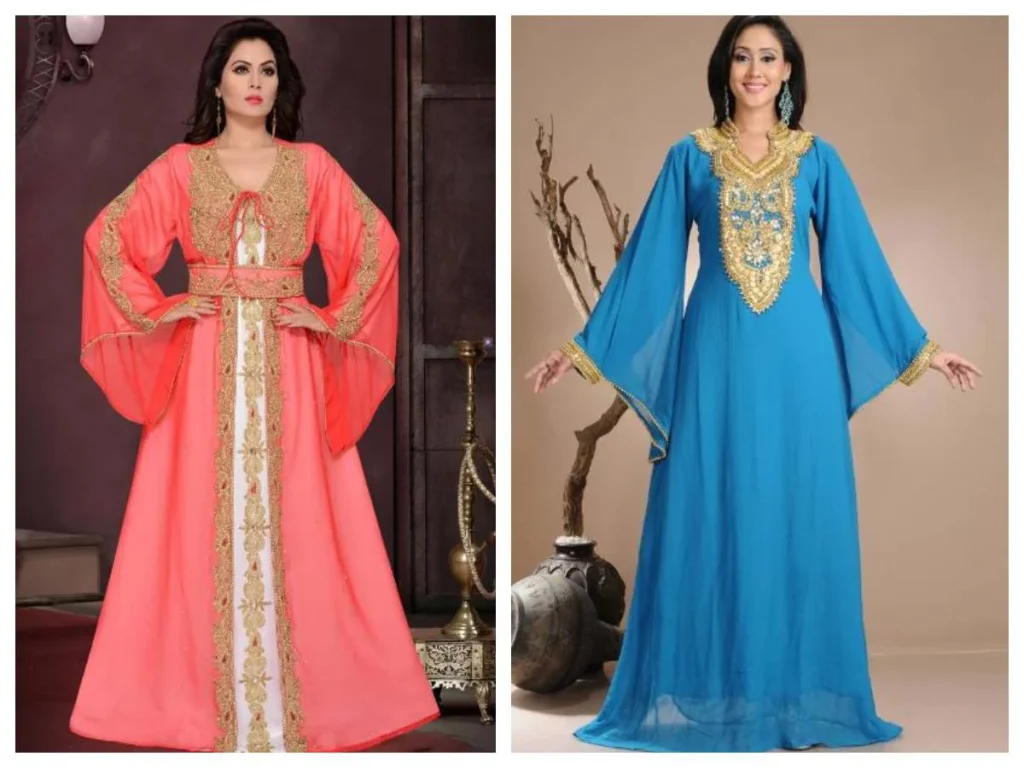The kaftan, a long loose-fitting garment with long sleeves, has become a staple in modern fashion across the globe. Originating in Mesopotamia around 3,000 BC, the kaftan was initially worn by men. It was later adopted into women’s fashion as well. Over the centuries, the kaftan has evolved from a utilitarian robe to a glamorous fashion statement, influencing styles from North Africa to Central Asia.
The kaftan first rose to global prominence through its use in Ottoman imperial courts in the 14th century. As the Ottoman Empire expanded its reach, so too did the kaftan dress and its cultural clout. By the 17th century, the kaftans had become a symbol of wealth, power and distinction in kingdoms as far away as West Africa where it was incorporated into local textile traditions. The ‘grand boubou,’ a flowing kaftan worn by West African royalty remains popular to this day for ceremonial events.
In Morocco, the kaftans reached its zenith as a fashion garment under the Saadi Dynasty in the 16th century. Richly embroidered Moroccan kaftans became important diplomatic gifts cementing Morocco’s trading partnerships across Europe and the Middle East. Moroccan kaftans featured a blend of local and imported fabrics including Italian velvets and English wool along with metallic threads from Istanbul for extra glitter. This global melange of materials, patterns and styles crystallized Morocco’s position as a center of global trade and diplomacy at the time.
The 20th century saw the kaftans re-emerge as a fashion staple, beginning with Parisian fashion icon Paul Poiret. In 1911, Poiret introduced a loose tunic dress inspired by 18th century Middle Eastern kaftans from his own personal collection. Other designers followed his lead. Soon, kaftan-style dresses and tops became popular in Hollywood movies as an exotic marker of glamour and sensuality.

In the 1960s and 70s, the kaftans became integral to hippie chic and bohemian fashion favored by music and movie stars like Elizabeth Taylor, Talitha Getty, Stevie Nicks and Gloria Swanson. The loose, flowing kaftans was perfect for the free-spirited aesthetic. Designers such as Valentino made the kaftan a staple on international catwalks showing glamorous floor-length versions.
More recently, kaftan-style dresses and tops have become a summer staple across the globe. From breezy cotton kaftans on European vacations to sequined versions for Arabian nights, the kaftan is now ubiquitous. Some observers have noted that the rise in global travel and cultural exchanges has corresponded with the kaftan’s renewed popularity.

Many modern fashion designers now cite the kaftans as a constant source of inspiration from maxi dresses to loose-fitting blouses and dresses. In India, Abu Jani and Sandeep Khosla are celebrated for their lavish kaftan gowns that fuse Mughal and Ottoman aesthetics. In Africa, label Tongoro has built a global fan base with its modern Senegalese kaftans. Meanwhile Max Mara’s Spring 2022 show featured kaftan-style coats, proving that the kaftan continues to transcend cultures.
Today the kaftans are appreciated both as a nostalgic historic garment, and a thoroughly contemporary fashion item. Its journey across centuries and cultures is a testament to the global nature of fashion. In many ways, the kaftan’s origins lie not in one single country, but across multiple civilizations that have traded textiles, styles and cultural influences. In every reincarnation, the appeal of the kaftan rests in its universality – its ability to flatter diverse body types while still retaining a relaxed, approachable aesthetic. The kaftan remains well poised to flow from culture to culture as fashion continues its global trajectory into the future.







